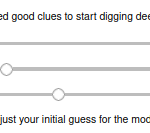
Project Gallery 2023
Secondary students from across Europe became exoplanet detectives with ESA and used Cheops satellite data to uncover the mysteries of two exoplanet targets: KELT-3b and TOI-560c.
Explore the projects below.
Hvězdičky
Gymnázium Matyáše Lercha Brno – Jihomoravský kraj Czech Republic 16 years old 2 / 2
TOI-560c
TOI-560c project description:
Hack an exoplanet is a project under the auspices of ESA (European Space Agency). In this case, we can also talk about a specific kind of hackathon. The satellite from ESA, Cheops (CHaracterising ExOPlanet Satellite) has earlier this year spotted two interesting exoplanets – KELT-3b and TOI-560c. And our goal is to analyze this data and get new informations about one of them.
A planet we have chosen is the planet TOI-560c, sometimes also referred to as Mini-Neptune.
What data do we already know? We know its mass (9.70 +1.80-1.70 MEarth) and its expected temperature (225 ± 15 °C). The planet TOI-560c orbits together with the planet TOI-560b around the small orange-red star TOI-560. This star is characterized by the quantities mass = 0.73 ± 0.02 MSun and radius = 0.65 ± 0.02 RSun. Therefore, we can be sure that this star is smaller than our Sun and at the same time cooler. This entire system is located in the constellation Hydra, about 103 light-years from Earth.
The given formulas (on the website) are also supposed to help us with the calculation of the data.
But what is indeed our task? We have to find out the radius of the selected planet, its orbital period, the distance from the host star, the density of the planet itself and thus its predicted composition compared to the planets of our Solar System.
TOI-560c Results and Analysis
THE SIZE OF THE EXOPLANET
First, we had a graph with data from CHEOPS. In it, we were supposed to create a model of reduced light from the star during the transit by what parameters fitted the model best. The parameters were: the radius of the host star (RS), which we did know from the file, the radius of the planet (RP) and mid-transit time. Then we were supposed to calculate the planet’s radius and compare it to the best model fit value from earlier.
RS = 0.65 RSun
RP = formula1 ≐ 0.029 RSun ≐ 3.17 REarth
Transit depth = 0.2 %
Our calculation was 0.07 REarth greater than our best-fit value in the Allesfitter, mainly because of our rounding of the transit depth. The final graph was also slightly tilted (graph 1) (table1) and from that, we can say that the light from the star was getting progressively smaller, which suggests that the satellite was getting slightly diverted after some time.
ORBITAL PERIOD
After creating the curve we were able to access new information (table2):
RP = 2.384+0,071-0,066 REarth
RS = 0.652+0,017-0,018 RSun
Mid-transit time = 0.4426+0,0050-0,0053 days
T = 18.8797 days
d = 0.1242 AU
* For any further calculations we were using these new informations
ORBITAL DISTANCE
With these newly acquired informations we were supposed to compare the orbital semi-major axis (d) from the archive and the one we’ve calculated.
d = formula2 ≐ 1.869 1010 m ≐ 0.1249 AU
Our calculation was 7.4 10-4 greater than the observations from the archive.
COMPOSITION AND DENSITY
The last equations we used were for the calculation of the density of the planet with the assumption that the planet is a perfect sphere.
V = formula3 ≐ 1.473 1028 cm^3
ρ = formula4 ≐ 3.934 g.cm^-3
TOI-560c Conclusions
In this project, we gathered some informations about the planet TOI-560c and in this part, we would like to sum them up.
Mass: 9.7 +1.80 -1.70 MEARTH
Radius: 2.384 +0.066 -0.071 REARTH
Density: 3.934 +1.173 -0.945 g/cm3
Orbital period: 18.8797 Days
Distance to host star: 0.124 +0,0011 -0.0012 AU
Temperature: 225 ± 15 ˚C
Discovered: 2021 by the TESS survey
From the calculated informations, we know that if the planet passed in front of the star on 23 January 2023 at 13:12 CET, it passed again on 11 February 2023 at 10:18 CET. From June 14 2023, the nearest transit for us will be June 23 at 14:06 CET.
The average temperature on the surface of the planet TOI-560c is about 225 ˚C, which is definitely too warm for any life to exist there (or at least the kind of life we know here on Earth). It is the temperature somewhere between the temperatures of Mercury and Venus surfaces.
The planet TOI-560c is approximately 2.4 larger and 9.7 heavier than Earth. Its orbital period is even shorter by 70 days compared to Merkur.
Compared with the density of other planets in the Solar system, TOI-560c is similar to Mars (Mars is a terrestrial, solid planet made of elements like silicon, oxygen, iron, magnesium, sulfur, phosphorus and aluminium).
According to the assumed composition of Mini-Neptunes, TOI-560c’s composition can be:
rocky core (made of metals such as iron)
envelope/core covering from water, ice or gas
atmosphere from helium and hydrogen
All things considered, we would like to say that it was really interesting for us to try something like this. We are really grateful for the opportunity to try this kind of project and also for everything new we have learned. We are already looking for another event.
Supporting files:






